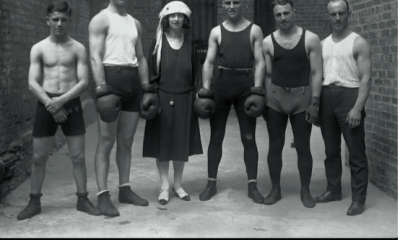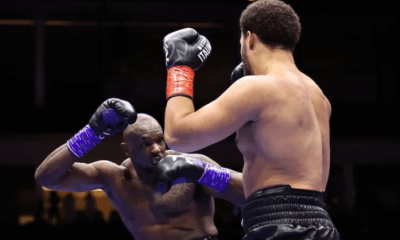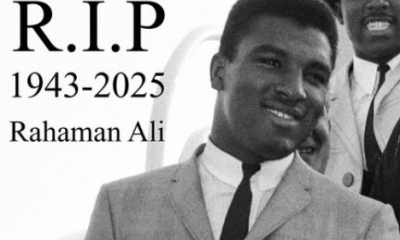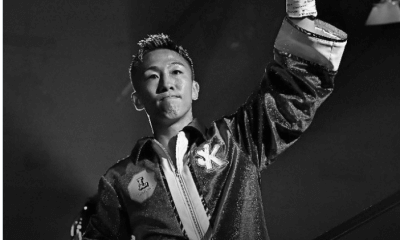Articles of 2006
It's No Big Deal, but Arum's War Talk Also Includes Junior Flyweight
LAS VEGAS, Aug. 9 – Gary Gittelsohn is all excited. This is different than his usual jitters. “You must watch him jump rope,” says the manager of the 108-pound titlist Brian Viloria, “he's the best I've seen since Duran.”
Roberto Duran used to imitate drunken Russian sailors while jumping rope. Gittelsohn finds it amazing when I tell him that Leon Spinks was a dancing marvel with the cords. Of course, publicist Bill Caplan remembers Sugar Ray Robinson, the rope-for-rope best, doing his act on the Ed Sullivan Show. Most people in the sweltering Top Rank Gym yesterday wouldn't have a clue about the Ed Sullivan Show, TV's top variety program for decades.
Viloria is good, real good, and yes, he can jump with Duran. Somebody says you ought to see Floyd Mayweather Jr. Viloria does tricks – folding up his right leg while continuing to jump. He says he started incorporating the tricks to alleviate boredom. The gym is host to a media gathering, to basically talk to the heavyweights, Hasim Rahman and Oleg Maskaev, who headline Bob Arum's pay-per-view card Saturday at the Thomas & Mack Arena. Arum threw in the 108-pounder because Viloria defends his title, and don't ask me which one, tomorrow night against Omar Nino Romero of Mexico at the Orleans in the second installment of the promoter's new TV series on OLN cable (I'm not sure, but I don't think OLN stands for “Over Lincoln, Nebraska).
While Romero may not be much of a challenger, the chances are always better that 108-pounders, and all their little brethren, will be more dazzling than the plodding heavyweights. Viloria will be paid proportionally to his size, not to his ability. The “Hawaiian Punch,” the prerequisite nickname of all fighters from the 50th State though Viloria's roots are deep in the Philippines, where he spent most of his first five years (his father said he couldn't find babysitters in Hawaii), will make maybe $80,000 this week; the heavyweights are both on the other side of seven figures.
Arum tries for some shtick. He poses for pictures in the main ring between his “smallest” champion, Viloria, and his “biggest,” Rahman. Then he suggests that Rahman pick up Viloria. Easily done and Rahman cradles the flyweight in his arms. Not that many minutes earlier, Caplan himself had done it. The XXXL publicist suggests Rahman try picking up someone his own size.
Naturally, anything so uplifting can not last in boxing. Once upon a time, Arum paid junior flyweights, or whatever you call the 108-pound class, a million dollars each – Olympian Mike Carbajal vs. Mexico's popular Humberto (Chiquita) Gonzalez in a unification bout.
“That was all built up,” Arum says, pointing to Carbajal's Olympic pedigree and Gonzalez becoming a star in Los Angeles at the Forum. That big fight, and the second and third acts that ensued, was virtually readymade. Arum didn't have to go to the whip to build up interest. Times have changed for the little guys, just as they have for the large ones.
There may be a future big bout – though certainly not $1 million each – if Ivan Calderon, another Arum fighter, moves up from 105 pounds, or if Viloria goes up to 112 and meets another little Arum star, Jorge Arce. But fight promoters must be visionaries. Arum has his eyes on Japan.
“They've got a kid over there, named Kameda (first name Koki), 19 years old, just won a title,” says Arum, “well, they gave it to him.”
“A total rob job,” says Viloria.
Arum says Kameda is so big in Japan he got a 52.9 TV rating – meaning more than half the sets in the country were watching him against Venezuela's Juan Landaeta.
“He's bigger than Mike Tyson was, he's the self-proclaimed Muhammad Ali of Japan,” says Viloria.
“I'm going to have Viloria say he'll fight him for nothing, to get even for what the Japanese did to the Filipinos,” says Arum.
“We have another legit angle, Pearl Harbor,” interjects Gittelsohn.
“We can have Douglas MacArthur come back,” Caplan suggests to his boss, the promoter who orchestrated the second comings of such heavyweights as George Foreman and Buster Douglas, though no one heard either say “I shall return” when they left boxing the first time.
“We can get someone to wear the sunglasses, hold the corn-cob pipe,” says Caplan, really into it now.
“He can be walking in water,” says Arum, conjuring up the staged photos of MacArthur going ashore.
Viloria is laughing. He does not walk on water, though he is a carpenter's son. His father, Ben, says “he could be anything, he got A grades in high school. He could have played soccer, any sport, but boxing got him into college.”
Viloria went to Northern Michigan, where trainer Al Mitchell runs a boxing camp, and though he majored in journalism, he knows better now. Now he is more interested in films, “producing or directing.” I can see him and Arum studying “Tora, Tora, Tora” together.
On the other side of the clean, well-lighted gym, Oleg Maskaev had been bristling about Arum's sales pitch for Saturday's heavyweight show, “America's Last Line of Defense.” Rahman is the only one of the four alphabet soup heavyweight champions from the United States. The other three – Wladimir Klitschko, Sergei Liahkovich and Nicolai Valuev – are from the former Soviet Union, as is Maskaev.
But Maskaev, unlike his former paisans, is now an American citizen. He lives in Staten Island, a rather red county in the midst of the blue sea that is New York City. He wryly resents being casted as the “foreigner,” saying that no matter who wins Saturday, an American will still hold at least one heavyweight title.
“Arum wants to keep fighting the Cold War,” Maskaev said.
War is hell, but the profiteers have their little golden linings. The boxing promoter, whose profession is to pay people to punch each other's heads for fun and profit, can rattle sabers when needed. The Cold War is for heavyweights. Junior flyweights get World War II.
Viloria doesn't mind. “Whatever it takes,” he says. He is not complaining about the $80,000 he's getting this week. Big fights, he says, “need two guys.”
Arum is saying maybe he'll take Viloria and Kameda to China, Hong Kong. He's been talking about Rahman, if he gets past Maskaev this time, fighting this fall in China, maybe in Macao, the former Portuguese enclave down the coast from Hong Kong where Arum's good Vegas buddy, Steve Wynn, is opening a casino.
Say this, Arum gets Kameda and what figures to be loads of Japanese TV money, there's no telling how high Viloria will jump.
PENTHOUSE: The Marquez brothers, for all the mismanagement by Nacho Beristain, are awfully good to watch and last weekend's Showtime doubleheader was better than usual. They were each in with tough, competent opposition – Rafael knocking out Silence Mabuza for a second time, though the South African had some nice moments. Then Juan Manuel, who had been showing signs of slippage, was more entertaining than ever in stopping Terdsak Jandong despite a nearly shut right eye. Beristain is obviously a brilliant trainer and hopefully new promoter Gary Shaw will keep the boys busy. Also fun to watch was Kassim Ouma, who showed Sechew Powell what life is like in the big leagues. The kid should profit from the loss, though. Now he knows what it means to stand up to pressure three minutes a round, every round.
OUTHOUSE: What were the judges watching? Or what was Harold Lederman seeing? Watching on the tube, I also thought Ike Quartey had won his crossroads bout with Vernon Forrest, but only by a point or two (one round, I lost the picture), including the uncalled for point deduction by Referee Arthur Mercante Jr. for an accidental low blow landed by Forrest. But to me, the result was no robbery – just a matter of disagreement. Neither mid-thirties guy looked like a serious player in the junior middleweight division, but both will get another nice payday (maybe even in a rematch). So who is in the OUTHOUSE? Anyone who scored this fight, like Lederman, by 5 points for one guy.
HOLY COW: Evander Holyfield turned down $100,000 to fight some shlub on the Roy Jones Jr. pay-per-view show from Boise, Idaho, in favor of promoting his own card next Friday in Dallas against the unesteemed Jeremy Bates. Guess what? The 43-year-old Holyfield, who also promotes, will probably make well over $500,000 – foreign TV and sponsorships making up $250,000, and this was before Fox Sports Network came aboard. It's hard to envision anyone having to hold a fundraising dinner for perhaps the second biggest earner in ring history, but when you have to staff a $38 million mansion – 109 rooms, 54,000 square feet – a half-million here or there doesn't hurt.
-

 Featured Articles3 weeks ago
Featured Articles3 weeks agoThe Hauser Report: Cinematic and Literary Notes
-

 Featured Articles4 weeks ago
Featured Articles4 weeks agoOscar Duarte and Regis Prograis Prevail on an Action-Packed Fight Card in Chicago
-

 Book Review3 weeks ago
Book Review3 weeks agoMark Kriegel’s New Book About Mike Tyson is a Must-Read
-

 Featured Articles1 week ago
Featured Articles1 week agoThe Hauser Report: Debunking Two Myths and Other Notes
-

 Featured Articles2 weeks ago
Featured Articles2 weeks agoMoses Itauma Continues his Rapid Rise; Steamrolls Dillian Whyte in Riyadh
-

 Featured Articles4 weeks ago
Featured Articles4 weeks agoRahaman Ali (1943-2025)
-

 Featured Articles4 weeks ago
Featured Articles4 weeks agoTop Rank Boxing is in Limbo, but that Hasn’t Benched Robert Garcia’s Up-and-Comers
-

 Featured Articles3 weeks ago
Featured Articles3 weeks agoKotari and Urakawa – Two Fatalities on the Same Card in Japan: Boxing’s Darkest Day














